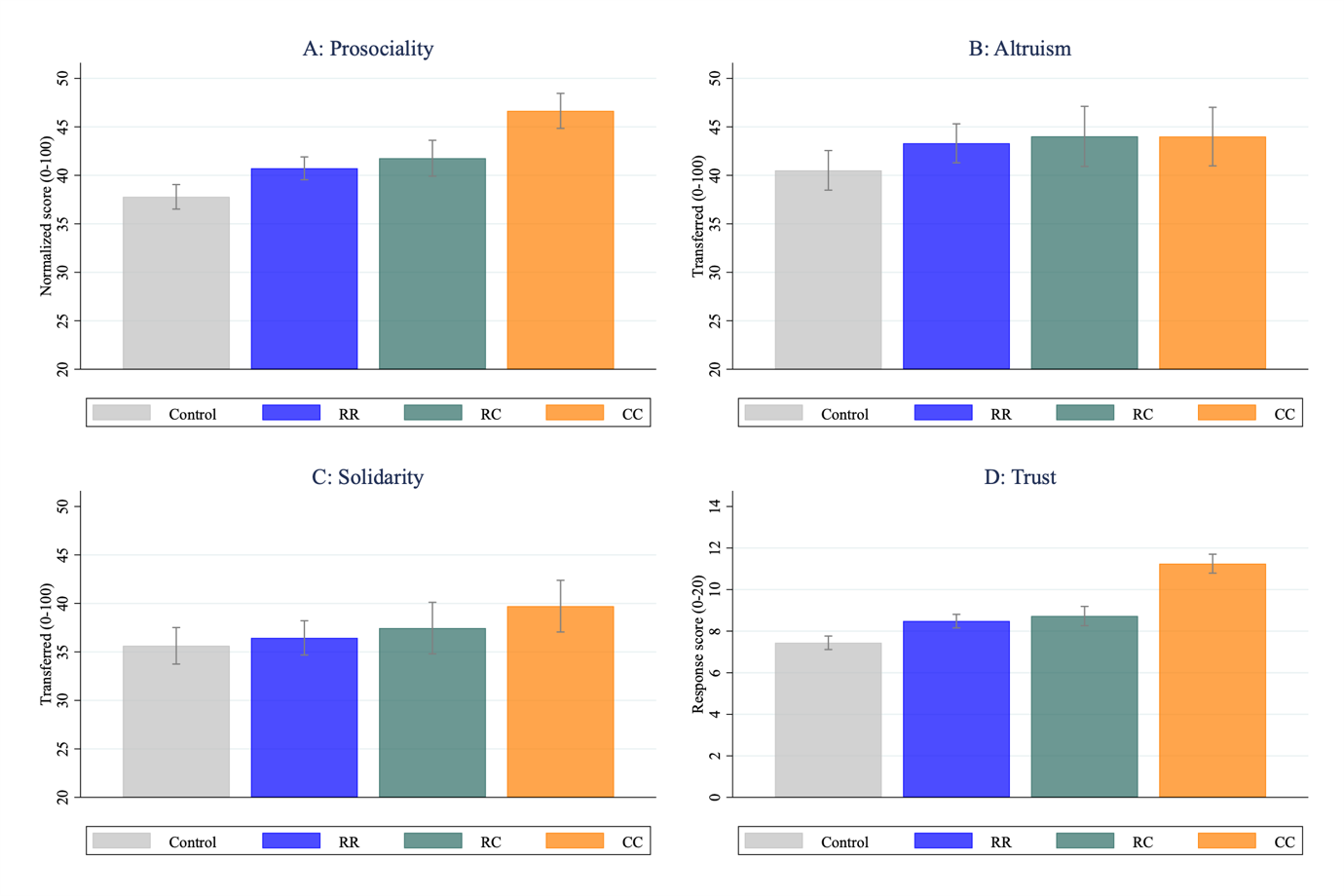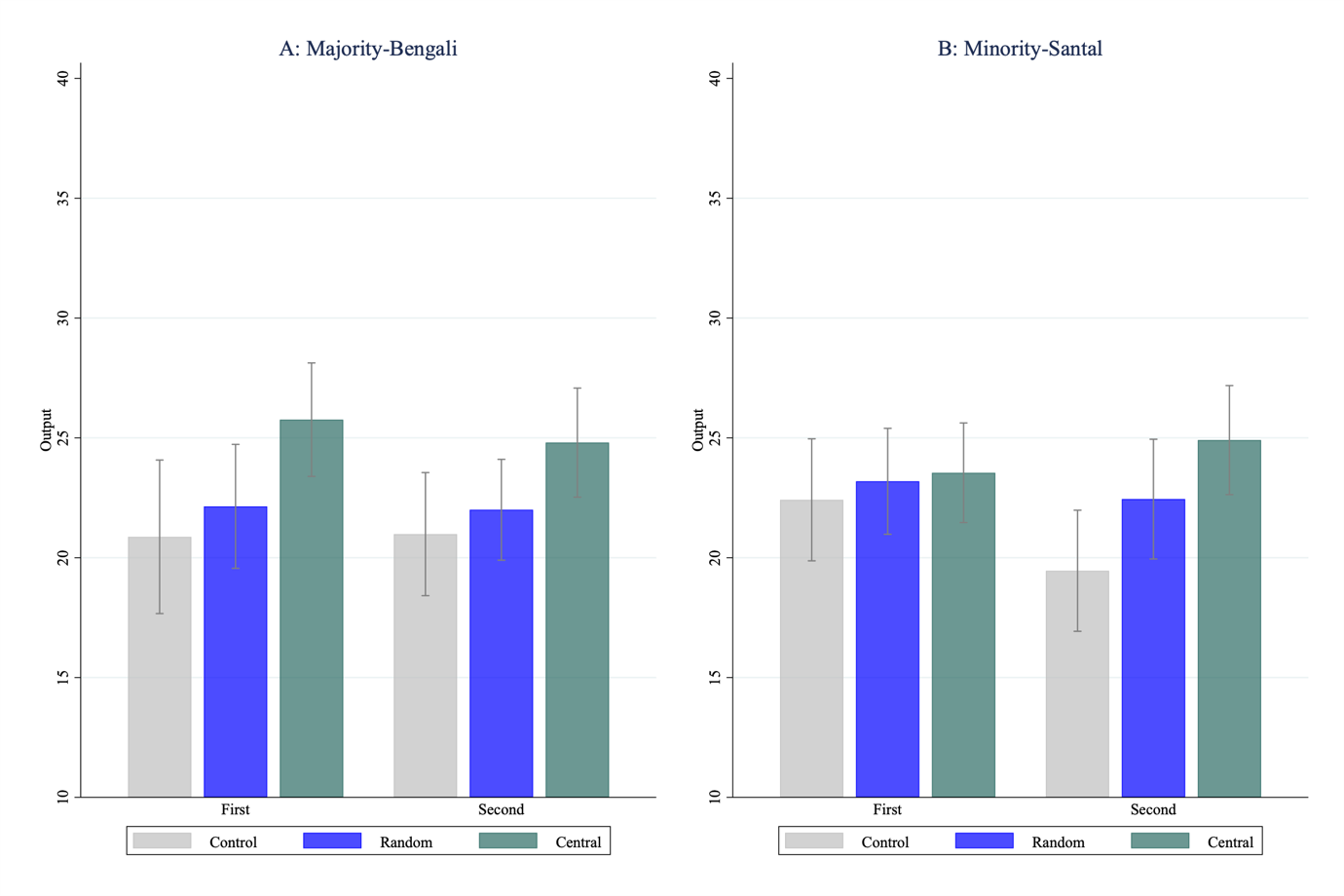
A documentary film, shown to a majority group, portraying the daily lives, cultural practices, and socioeconomic struggles of a minority group in Bangladesh, increased prosociality and reduced complaints against the minority.
Interethnic tensions are a widespread issue with significant implications for social cohesion and economic development. In many developing countries, ethnic minorities face exclusionary and discriminatory practices from dominant majority groups, which limit their access to opportunities and hinder their socioeconomic advancement. Reducing these ethnic frictions is crucial to enabling equitable growth and improving social relations (Alesina and La Ferrara 2005).
In Bangladesh, a country home to over 45 ethnic minority groups, these tensions are especially pronounced. One such marginalised group is the Santals, who reside primarily in the northwestern region of Bangladesh. The Santals have a rich cultural heritage but often face limited economic opportunities, discrimination, and social exclusion (Roy 2012, Siddique et al. 2023). Their marginalisation is exacerbated by negative stereotypes and discriminatory opinions held by the Bengali majority, hindering their socioeconomic progress and integration into the broader society.
The intervention: Using edutainment to promote interethnic harmony
To address negative perceptions of Santals among Bengalis (the ethnic majority group) and promote interethnic harmony, we designed a novel intervention using edutainment—a form of entertainment with an educational component. In our study (Siddique et al. 2024), we produced a documentary film, which portrays the daily lives, cultural practices, and socioeconomic struggles of the Santals in a non-judgmental and engaging manner. The film focused on three key aspects of Santal life: their cultural practices, the economic challenges they face, and examples of Santals succeeding in education and their professional lives. By using visual storytelling, the film sought to humanise the Santals and shift the majority's attitudes.
Note: Documentary film used in the field experiment in Bangladesh.
We hypothesised that exposure to the documentary would foster empathy and understanding among the Bengali majority towards the Santals, leading to improved interethnic relations. Direct contact is often argued as an effective means to reduce prejudice by facilitating learning about the outgroup and inducing positive emotions (empathy) toward them (Allport 1954). In our intevention, we aimed to achieve a similar effect through virtual contact using visual storytelling, as an alternative to direct contact.
To test this hypothesis, we conducted a cluster-randomised field experiment in 121 polyethnic villages in Bangladesh, with a sample of over 3,300 households. Villages were randomly assigned to one of three groups:
- The Control group, where randomly selected Bengalis viewed a placebo film unrelated to interethnic relations,
- The Random Treatment group where randomly selected Bengalis watched the documentary on the Santals, and
- The Network-Central Treatment group that targeted both randomly selected Bengalis and those with high diffusion centrality, who could spread information widely through social networks (Banerjee et al. 2019).
To assess the potential spillover effects, we also collected data from untreated individuals—both Bengali and Santal—in each study village.
How did we measure the impact of the documentary on interethnic harmony?
We measured interethnic harmony in three objective ways:
Prosociality (altruism, solidarity, and trust): We administered lab-in-the-field experiments and experimentally validated surveys to measure prosocial behaviours towards non-coethnics, such as altruism, solidarity, and trust.
Complaints to public authorities: We examined data from village counselors’ offices and police stations to track the number of complaints filed by Bengalis against Santals. A reduction in these complaints would indicate improved interethnic relations, as complaints often lead to serious consequences for the minority group.
Labour market interactions: We conducted a casual work field experiment involving 720 randomly selected participants from the main study, where pairs of Bengali and Santal workers jointly produced paper bags for a local supplier. Workers were paid a piece rate for each finished paper bag. Each worker was assigned a specific role, either preparing the materials or finishing the final product. The team’s combined output determined their earnings, which were then divided equally between them. We hypothesised that Bengalis who watched the documentary and developed greater goodwill towards Santals would demonstrate higher productivity in their assigned tasks, compared to those in the control group.
Changing Bengali’s attitudes towards the Santals
Increased prosociality: Three months after viewing the documentary, Bengalis showed significantly more prosocial behaviour toward Santals compared to the control group (see Figure 1). These positive behaviours were also observed among untreated individuals, suggesting a positive spillover effect. These findings support our hypothesis that fostering empathy can lead to improved intergroup relations.
Reduction in complaints: Data on police complaints further supported improved relations. In the ‘Central’ arm, there was a significant reduction in complaints made by Bengalis against Santals post-intervention. This finding indicates that the film's influence extended beyond the experimental setting and had real-world implications for intergroup harmony.
Figure 1: Impact on prosociality towards ethnic minorities

Note: Prosociality is a normalised index, between 0 and 100, that combines altruism, solidarity, and trust, placing equal weight to each. In each graph, higher bars correspond to more favorable outcomes.
Higher productivity in mixed ethnicity teams: In the casual work field experiment, we observed a 5% increase in productivity in the ‘Central’ arm, with both Bengalis and Santals showing greater productivity when assigned the finisher role (see Figure 2). This suggests that increased prosociality toward Santals motivated Bengalis to work harder, which in turn encouraged Santals to match their effort—likely driven by peer pressure or conformity.
Figure 2: Output as Finisher, by ethnicity

Note: Each bar shows the average output produced, with 95% confidence intervals. Participants assigned the finisher role at the start of the task are classified as ‘First’. Participants completing the task in the finisher role are classified as ‘Second’.
What drove the improvement in inter-ethnic harmony between Bengalis and Santals?
To explore the potential mechanisms behind the observed effects, we examined whether the documentary shifted participants’ beliefs, attitudes, and interactions with the Santal community. Additionally, we analysed whether the film elicited empathy or emotional responses, which could have driven the behavioural changes observed.
- Information channels: Quantitative survey data show that the intervention had limited impact on changing Bengalis’ beliefs about Santals or increasing direct interactions. This could be because changing how people think (cognitive components) is more difficult than changing how people feel (affective components). Additionally, Bengalis might have resisted to change their long-held beliefs and generational biases against Santals, and they might not want to go against social norms.
- Emotion channels: We analysed the emotional impact of the documentary by examining viewers’ facial expressions during the screening using emotion-detection software. The results indicated that the documentary elicited sadness among the viewers, particularly those in the network-central group, who exhibited significantly more instances of sadness compared to the control group.
- Qualitative evidence: In-person interviews conducted immediately after the film screening provided more detailed insights into Bengali participants’ intentions and motivations to help Santals. These interviews revealed that 50% of participants expressed a general intention to help Santals, with 20% specifically focused on providing financial aid. Additionally, participants in the treatment groups expressed a desire to encourage their neighbours to support the Santals, with 50% indicating general support and 20% specifically mentioning financial assistance.
Using documentary films to foster interethnic harmony
We investigated the use of documentary films and social relationships as a tool for fostering positive interethnic relations. Although we did not test the scalability of this intervention, our findings offer valuable insights for policymakers. Documentary films are a scalable and low-cost tool that can reach large audiences, making them a viable option for governments and organisations seeking to address social divides in resource-constrained settings. Given the emotional resonance of visual storytelling, such interventions can foster empathy and cooperation across ethnic lines without requiring direct contact, which may be difficult in conflict-prone areas. By incorporating these types of edutainment interventions into broader social cohesion strategies, policymakers can promote interethnic harmony and reduce conflict on a large scale.
References
Alesina, A., & La Ferrara, E. (2005). Ethnic diversity and economic performance. Journal of Economic Literature, 43(3), 762-800.
Allport, G. W. (1954). The Nature of Prejudice. Cambridge, MA: Addison-Wesley.
Banerjee, A., Chandrasekhar, A. G., Duflo, E., & Jackson, M. O. (2019). Using gossips to spread information: Theory and evidence from two randomized controlled trials. Review of Economic Studies, 86(6), 2453–2490.
Roy, R. D. (2012). Country technical notes on indigenous peoples’ issues: People’s Republic of Bangladesh. IFAD Country Report.
Siddique, A., Vlassopoulos, M., & Zenou, Y. (2023). Market competition and discrimination. European Economic Review, 152, 104361.
Siddique, A., Vlassopoulos, M., & Zenou, Y. (2024). Leveraging edutainment and social networks to foster interethnic harmony. CEPR Working Paper no. 19034.


